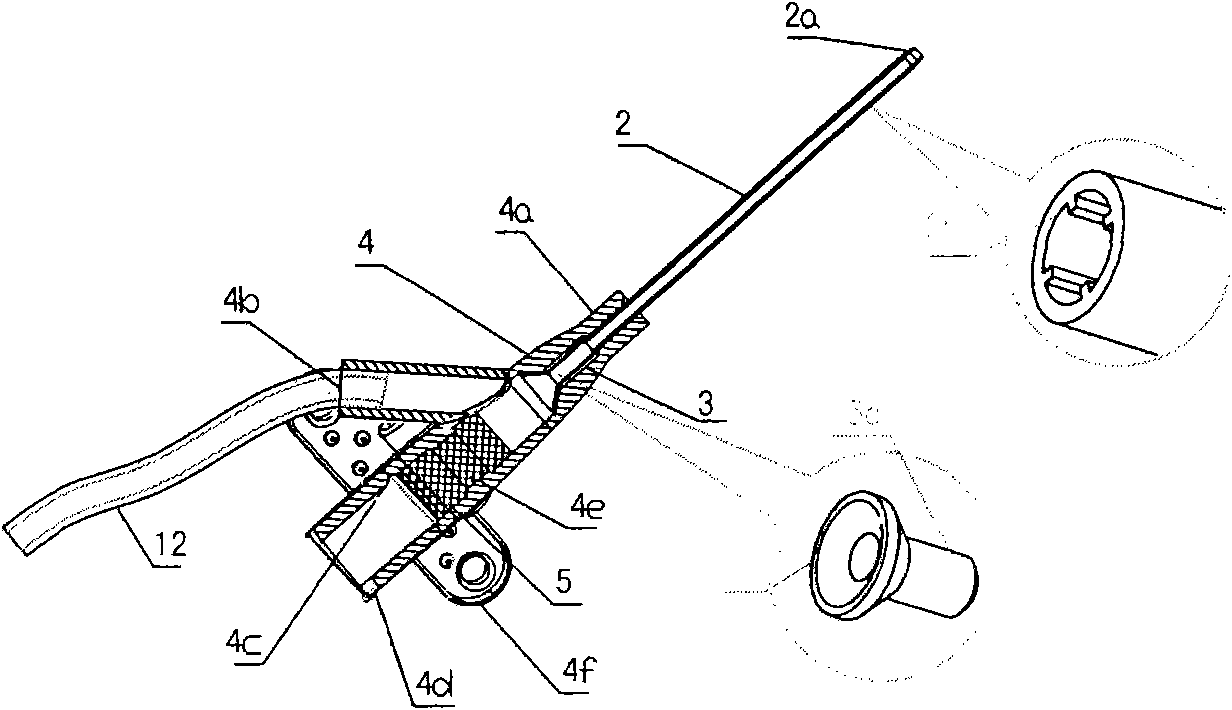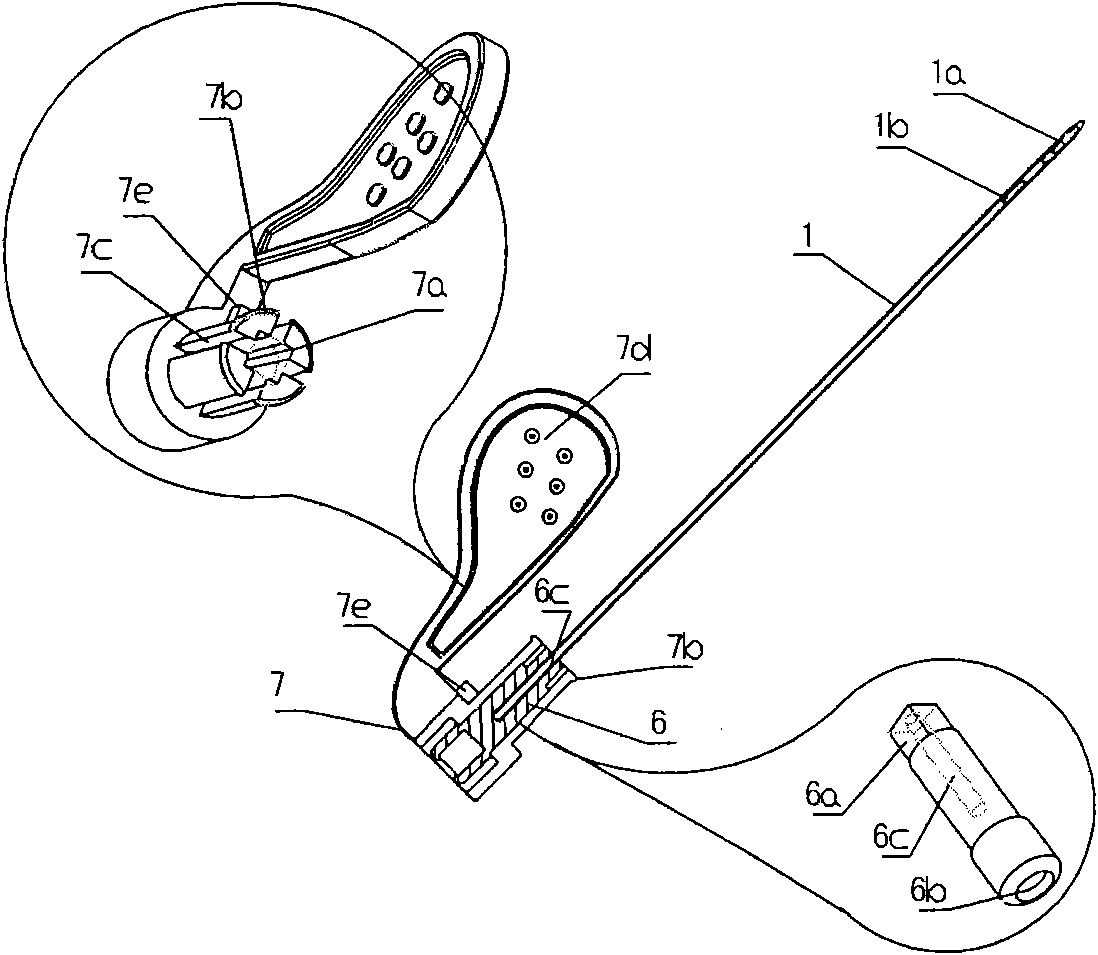[0003] One is: there is a
safety risk for users and surrounding personnel: since the
metal puncture needle needs to penetrate the indwelling needle, its length is longer than that of ordinary puncture needles. After the puncture is pulled out, there is no protection on the outside, which is likely to cause
medical staff and future
medical waste. Handlers are injured by needles, and there is a risk of nosocomial infection caused by viruses contained in
blood stains remaining on needle tubes
[0004] The second is: there is a
safety risk to the patient and the surrounding personnel: since the indwelling needle base has the same structure as the ordinary puncture needle base, there is no measure or device to prevent blood
backflow (
reflux), so that after the puncture needle is pulled out, the blood will flow back and pollute the environment (
medical staff and the surrounding
population)
human body, forming a
safety risk; moreover, in the process of repeated infusion with the indwelling needle, the action of pulling out the infusion connector after each infusion will inevitably form a certain negative pressure in the inner cavity of the indwelling needle, which will cause Cause blood
backflow into the indwelling needle tube, blood coagulation will occur, and
embolus will be formed. When it is used again, because the indwelling needle channel is blocked, it needs to be punctured again, which will affect the treatment and increase the labor of
medical staff; moreover, if the
embolus enters the
blood vessel, then It will enter different tissues or organs of the
human body with the
blood flow, causing
embolism of blood vessels in the tissue or organ, and can cause
ischemia and
necrosis of the organ in serious cases, with very serious and dangerous consequences
[0005] The third is: increase the labor intensity of
medical care, the operation is cumbersome, and after the
embolism occurs, it needs to be punctured again, which will increase the pain and burden of the patient and limit its application
Chinese patent: CN200620080001.2 discloses another method for automatically preventing blood
reflux and overflow, which is to install a sealing plug and a conducting bracket in the
tail cavity of the indwelling needle seat, the rubber sealing plug seals the liquid flow channel, and the conducting bracket ( Sleeve) penetrates the sealing plug under the action of external force (
infusion set or
syringe or
catheter socket) and conducts again, but it does not explain how the conductive support is separated from the sealing plug and sealed again after the socket of the
infusion set is pulled out Therefore, this solution can only meet the one-time use of the indwelling needle and the liquid pipeline interface
Chinese patent: CN200510051051.8 discloses a method of safely indwelling the needle, which is to make an enlarged needle body at the front end of the puncture needle, so as to limit the slipping of the needle tip protection sleeve on the needle body in the front section of the needle tip, and protect the needle tip solution; because it only protects the needle tip, and the needle body is still exposed, the
blood stains on the needle body are still a serious source of infection for medical staff
Its
advantage is that it overcomes the problem of
embolism caused by venous return and shields the needle tip, avoiding the risk of needle stick injury. However, there are also some shortcomings: that is, although the puncture needle tip is shielded, the puncture needle body is still exposed, which is different from the needle tip. B.Braun's technical protection scheme also has the risk of
blood stains on the needle body contaminating the human body
[0007] Chinese patents CN200620076287.7 and CN200720018504.0 disclose two kinds of indwelling needles with
positive pressure airtight valves. Although they solve the blood
backflow phenomenon when the puncture needle is pulled out, they cannot solve the problem of needle stick injury
[0008] None of the technical solutions disclosed above solves the fundamental problems existing in the indwelling needle at present, or there are certain inconveniences and deficiencies in the clinical operation process:
[0009] 1. In the process of pulling out the puncture needle after successful vascular puncture, it cannot effectively prevent blood from spilling out of the needle channel, which may cause
contamination or cross-
infection risks[0010] 2. The puncture needle tip protection device is not perfect or unreasonable
As in the above-mentioned published patent, the needle tube is made of an enlarged ball, although it is enough to limit the shedding of the protective sleeve, but there is resistance or obstacles in the process of inserting the needle tube into the indwelling needle hose and the needle seat
[0011] 3. After the socket of the indwelling needle is plugged into the socket of the
infusion set or
syringe or liquid infusion device for infusion, after the socket is pulled out, the negative pressure of the blood in the
blood vessel due to the pullout of the socket will cause the blood to flow back, and the blood will flow into the indwelling needle and become soft. The tube coagulates and the indwelling needle is blocked, resulting in inability to re-infusion. In severe cases, the blood clot falls off and enters the
blood vessel. With the
blood flow, it will cause venous embolism in small blood vessels, causing
ischemic necrosis of some tissues or organs, and causing serious consequences.
[0012] 4. The front-end protection scheme of the
metal clip and protective cap can only protect the needle tip and eliminate needle stick injuries, but it cannot completely shield the needle body, and there is a risk of blood
stain contamination[0013] 5. The method of adding a complete protective sleeve at the end of the puncture needle seat (the side of the sheath tube is slit, which is beneficial to the withdrawal of the puncture needle), although the puncture needle can be completely protected, but due to the increase in product volume and length, the The puncture needle body and the sheath tube interfere with the clinical operation process, increase the product packaging volume and increase the product cost, especially the bad hand feeling and inconvenient operation, which affect the puncture accuracy
However, because the puncture needle protection scheme uses a spring to release the elastic force of the protective sleeve and shield the puncture needle, there is also the risk of
contamination of others by the blood-stained
body fluid contaminated by the needle tube body. Therefore, this scheme can only prevent needle sticks damage, but cannot achieve real and thorough safety protection
 Login to View More
Login to View More  Login to View More
Login to View More 


